Domestic post-war aircraft guns caliber 23 mm. Part I
Soon after the war, it was decided to make the minimum caliber of 23 mm aircraft cannons. One of the main advantages of 23-mm guns over 20-millimeter were the characteristics of the projectile. With a small increase in the caliber and dimensions of the munition, it was possible to almost double the mass of the projectile, which should have affected its capabilities accordingly.
NA-23
The main 23-mm aviation weapon in the years of the Great Patriotic War was the gun WYa-23. With sufficiently high performance, it had a considerable return. To solve this problem, it was decided to develop a new cannon for a new ammunition. The 23 x115 mm projectile mm appeared in the 1943 year. Employees of OKB-16 took a projectile from the existing 23x152 mm ammunition and connected it with a case borrowed from the 14,5x114 mm cartridge for anti-tank guns. While maintaining the basic fighting qualities, the new projectile turned out to be smaller and lighter than the old one.

The first weapon under the new ammunition was the automatic gun NS-23, created by the designers of OKB-16 under the direction of A.E. Nudelman and A.S. Suranova. The development of the NA-23 gun was launched in 1943, but it became very popular in the first post-war years. The aim of the project was to create a new automatic cannon for the 23х115 mm projectile, which in its characteristics is not inferior to existing systems of the same caliber.
A new gun with a total length of 1985 mm and a weight of 37 kg had a barrel length of 1450 mm. Automation tools worked by the energy of recoil with a short course of the barrel. After ramming the barrel, the barrel was locked with a rotating piston bolt. There was a run-up accelerator. To simplify the design of the gun, an interesting system of extraction of spent cartridges was used: as the bolt moved, it was pushed out by a new cartridge. Separate extractor was not used. The power supply was carried out using a detachable metal tape. Fire control was carried out using electrostart. For installation on the aircraft gun was equipped with two attachment points.
The new gun had some advantages over the WL-23, primarily in its own weight and ammunition weight. In addition, recoil decreased by 60%. However, the lower weight of the propellant charge of the new projectile affected the characteristics of the gun. With a rate of fire of about 600 rounds per minute, the NS-23 gun provided the initial velocity of the projectile at the level of 690 m / s. The HC-23 was inferior to the WL-23 not only in the initial velocity of the projectile, but also in the second salvo: 1,85 kg versus 2 kg. Tool life equaled 4 thousands of shots.
Two types of projectiles were proposed for use with the HC-23 gun. The incendiary missile pack had a total weight of 200 g, carried an 15 g of explosive and was equipped with an A-23 fuse. An armor-piercing incendiary projectile with the same mass carried 5-7 g of explosive and did not have a fuse. From a distance of 200 m, an armor-piercing incendiary projectile could penetrate an armor plate 25 mm thick.
In the spring and summer of 1944, tests of a new automatic gun took place on the ground stand and on the Yak-9 fighter. Despite the shortcomings, the NS-23 gun was recommended for adoption. The corresponding decision of the State Defense Committee appeared in early October 44 th.
The production of the NS-23 cannons began at plant number 2 (now the Degtyarev Plant, Kovrov). Until the end of 1944, three hundred guns were assembled in Kovrov. For 45, gunsmiths produced over 600 new guns. The pace of production in the 1946 year was less - only 530 guns. The situation changed dramatically in the 1947 year. The appearance of the first domestic jet fighters, who needed automatic guns, led to the fact that in 47 plant No. 2 assembled about 6 thousand НС-23. Before 1950, in Kovrov, about 22,5 thousand guns were manufactured. In 1951-53, production was conducted at the Tula factory No.535, which during this time produced 6 thousand guns.
The first aircraft that received the NS-23 gun was the Il-10 attack aircraft, created in 1944 year. Each such attack aircraft carried two guns in the HC-23KM modification (“wing-engine” with some modifications related to the installation features). In 1946, the HC-23C (with a synchronizer firing through the screw) armed the La-9 and La-11 fighter jets. These aircraft were equipped with four and three guns, respectively. A variant of the NS-23KM guns with elongated barrels armed Yak-15 fighter jet (carrying two guns). In addition, various modifications of the NS-23 cannon equipped the MiG-9, MiG-15 and Yak-17 fighters.
HP-23
In 1947, the military demanded that the HC-23 cannon be upgraded, increasing the rate of fire and the initial velocity of the projectile. In addition, since the end of 1946, the OKB-16 designers have studied ways to improve the cannon, including the creation of a double-sided feed of ammunition tape. Work on the modernized tool was conducted under the leadership of A.E. Nudelman and A.A. Richter, with the result that the new project received the designation HP-23.
The design of the new automatic cannon widely used developments under the project NA-23. In fact, HP-23 was a HC-23 with several modified and refined nodes. The length of the barrel remained the same - 1450 mm, but the total length of the gun has increased to 2018 mm. The mass of the structure has grown to 39 kg. The principle of operation of the automation remained the same, but to increase the rate of fire, rollback and roll forward accelerators were introduced into the design. To reduce recoil used hydrobuffer. The ammunition system underwent some changes: the new gun could have received projectiles from both sides. In connection with the use of double-sided projectile feed, new sections of detachable metal tape had to be developed.
All innovations applied in the design of the automatic gun HP-23, affected its characteristics. The gun’s rate of fire was able to reach 800-950 shots per minute, but the initial velocity of the projectile remained at the level of the HC-23 cannon — on the order of 690 m / s. The use of kickback and roll forward accelerators, which made it possible to increase the rate of fire, affected the wear of some parts. The survivability of the HP-23 gun was a quarter less than that of the base NS-23 - 3 thousand shots. In the 1951 year, at the request of the military, the resource was doubled and brought to 6 thousand shots.
The development of the HP-23 gun ended in the 1948 year. After several stages of testing in the same year, its mass production began. Plant No. XXUMX (Kovrov) and Plant No. XXUMX (Kuibyshev) were involved in the manufacture of new aircraft guns. Officially, the HP-2 was adopted in 525 year. Until the end of 23, the entire 1950 guns of the new model were assembled. Already in 1948, the number of guns released exceeded 280, and in 49, it passed the mark of 1200 units. In 50, the Kovrov and Kuibyshev plants collected more than 5800 thousand guns, and in 1951 a record was set - 12 guns. After that, the pace of production began to fall markedly. The last 52 guns of the HP-18572 were manufactured in the 6350 year.
The fighter jet La-23 has become the platform for testing the HP-15 cannon. Serial cars of this model were equipped with three guns. As a course weapon, the HP-23 guns were used on several types of fighters: Yak-23 (two guns), MiG-15bis (two), MiG-17 (two), MiG-19 (two or three, depending on the version). The four HP-23 guns carried late modifications of the Il-10 attack aircraft. Long-range Tu-4 bombers received ten guns of this type during the modernization. The Il-28 front bomber was equipped with four guns (two course and two in the aft artillery installation). In addition to it, the An-12 transport aircraft and the Be-6 flying boat carried the stern turret. The latter was also equipped with one gun on the bow installation and two on the deck.
In the mid-fifties, the documentation on the HP-23 automatic gun was transferred to China. The licensed version of the gun called the Type 23 was installed on various fighters, attack aircraft and Chinese-made bombers.
According to some data, at the early stages of the development of the Almaz orbital stations, it was the HP-23 gun that was considered as their main weapon. Later it was proposed to replace the barrel arms with rocket.
AM-23
In the early fifties, employees of the Tula TsKB-14 (now the Instrument Design Bureau) under the direction of N.M. Afanasyev created a large-caliber machine gun A-12,7. The design of this weapon was taken as the basis for the new automatic gun caliber 23 mm. Works on the AM-23 tool started in 1953 year. The project was headed by N.M. Afanasyev and N.F. Makarov.
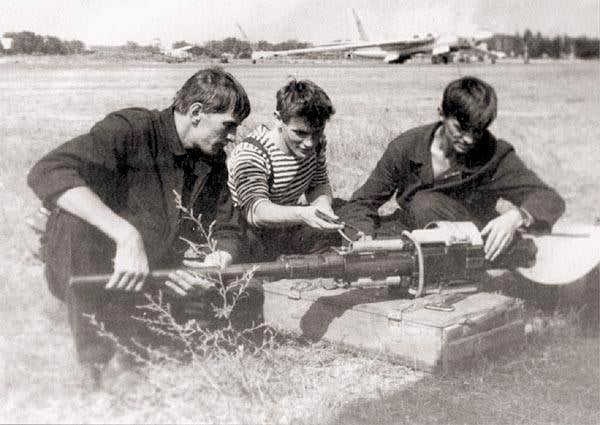
Technicians perform maintenance on the AM-23 gun in field conditions.
Initially it was assumed that the new gun will use the old projectile 23x152 mm. This ammunition could provide sufficiently high performance, and was also mastered in production. However, soon there was a proposal to develop a second version of the gun, designed to use projectiles 23x115 mm. Both versions of the automatic guns were developed in parallel. In 1951, TsKB-14 conducted a comparative test of two guns and came to the conclusion that it was necessary to continue work on the second version of the project, which used a projectile of the new model. The main advantage of the ammunition 23x115 mm considered smaller dimensions and weight, more suitable for use on aircraft.
Both versions of the AM-23 gun were built according to the same scheme and used automation based on the removal of powder gases. An interesting feature of the gun Afanasyev and Makarov was the gas buffer. To mitigate the impact of the moving parts of the automation, when they reached the extreme rear position, a gas buffer was used, which had its own flue gas tube. In the rifled barrel there were two gas vents: gases came to the piston through an opening with a diameter of 6,5 mm, to the buffer - through 4-mm. The use of the buffer made it possible to reduce the weight of the gun, as well as to increase the resource of its individual parts.
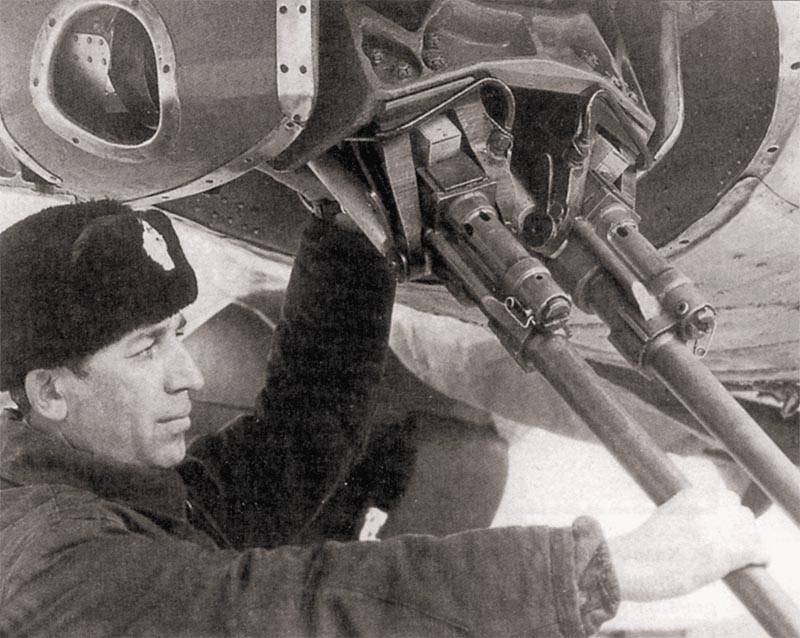
Inspection of the AM-23 guns on the DT-7N mobile lower mount of the Tu-16 bomber
The gun received a wedge bolt moving in an inclined vertical nest of the receiver. An important innovation in the design of the gun was leverage rammer, which pushed the projectile out of the tape and sent it to the barrel. Thanks to the use of all these technical solutions, the rate of fire of a new cannon for ammunition 23х115 mm reached 1200-1250 rounds per minute with an initial velocity of the projectile 690 m / s. At the same time, the AM-23 gun was compact and light enough. The total length when using the 1000-mm barrel did not exceed 1470 mm. Cannon Weight - 44 kg. Vitality - 6000 shots.
To quench the recoil pulse, the gun was equipped with spring-loaded otkatnikami. In addition, the gun was equipped with a pneumatic reloading system, which ensured the movement of the moving parts of the gun in any direction. The AM-23 cannon was supplied with a metal detachable tape. Ammunition could be fed into one of the two receiving windows of the gun, on the right and left sides of the receiver. To change the direction of the projectiles supply, intervention was required.
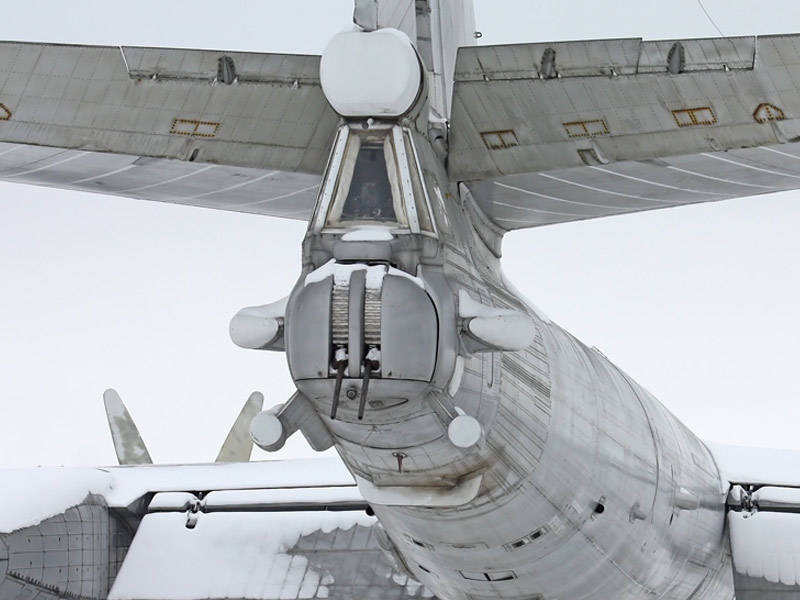
Aft gun installation with guns AM-23 Radar PRS-1 "Argon" / BOX TAIL and antennas of the EW Sayany-M station on Tu-142М3 aircraft N85 serial No.8601903 of the USSR Navy in the museum at Zhuliany airfield Ukraine, 15.03.2010 (author of the photo - Alexey Vlasov, http://russianplanes.net)
The high-explosive fragmentation projectile, high-explosive fragmentation with tracer, armor-piercing incendiary with tracer and multielement (fragmentation with ready-made fragments) were present in the nomenclature of ammunition for the AM-23 cannon. In the early sixties, a DOS-15 projectile, equipped with dipole reflectors, was built to fight enemy radar stations.
In 1953, the AM-23 cannon for the 23х115 mm projectile (this version of the gun was designated as the TKB-495 index) was submitted for testing. At the same time, a competition was held in which, in addition to AM-23, similar developments from OKB-16 (product "220P") and OKB-15 (Sh-23) took part. According to the results of the comparison, the gun of the Tula designers was recognized as the best of the samples presented. In the spring of 1954, it was put into service under the name AM-23 (9A-036).
Serial production of automatic guns AM-23 began in 1953 year, during which 56 guns of this model were assembled. The adoption of a weapon has affected the pace of production: in 1954-m was produced more than 1000 units. Mass production of guns AM-23 continued until the end of the seventies. It was made more than 11 thousand guns.
During the serial production of TsKB-14, and then the instrument design bureau developed two modifications of the gun. In the variant AM-23Л1, the gun received a choke nozzle of the model L1 and a barrel of length 1450 mm, with the result that its full length reached 1770 mm and the initial velocity of the projectile exceeded 700 m / s. Modification AL-23Л2 was equipped with a muzzle nozzle L3.

AM-23 cannons in the 3MD long-range bomber turret
The AM-23 cannon of all modifications was equipped with airplanes of various types and classes. The 3, Il-54, Tu-16 and Tu-95 bombers, the An-8, An-12 and Il-76 (early series) transport aircraft, as well as the 125 project border boats armed themselves with this weapon. In almost all cases, the AM-23 guns were mounted on twin turrets with remote control. The exception is the early modifications of the Tu-16 bomber, which carried three twin turrets and one course gun in the bow.
Based on:
http://airwar.ru/
http://airpages.ru/
http://museum-arms.ru/
http://russianarms.mybb.ru/
http://zid.ru/
Shirokorad A. B. History aviation weapons. - Mn .: Harvest, 1999
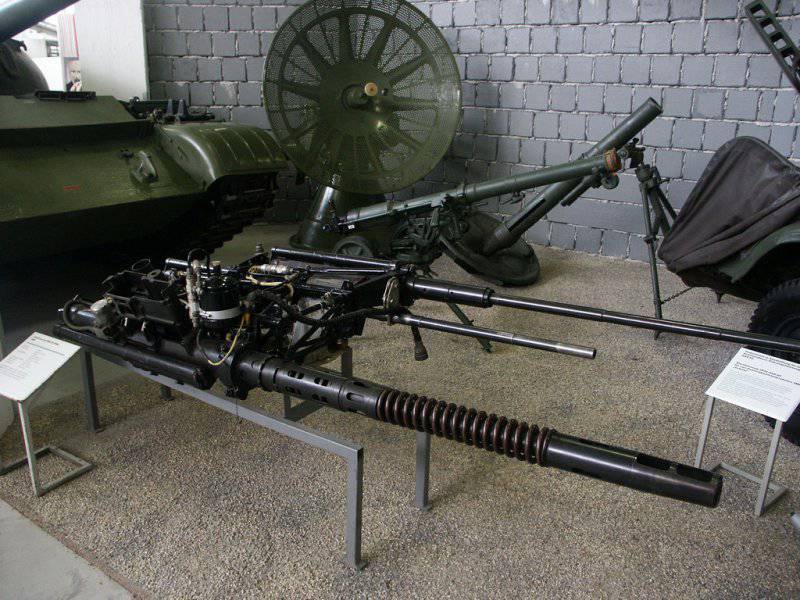
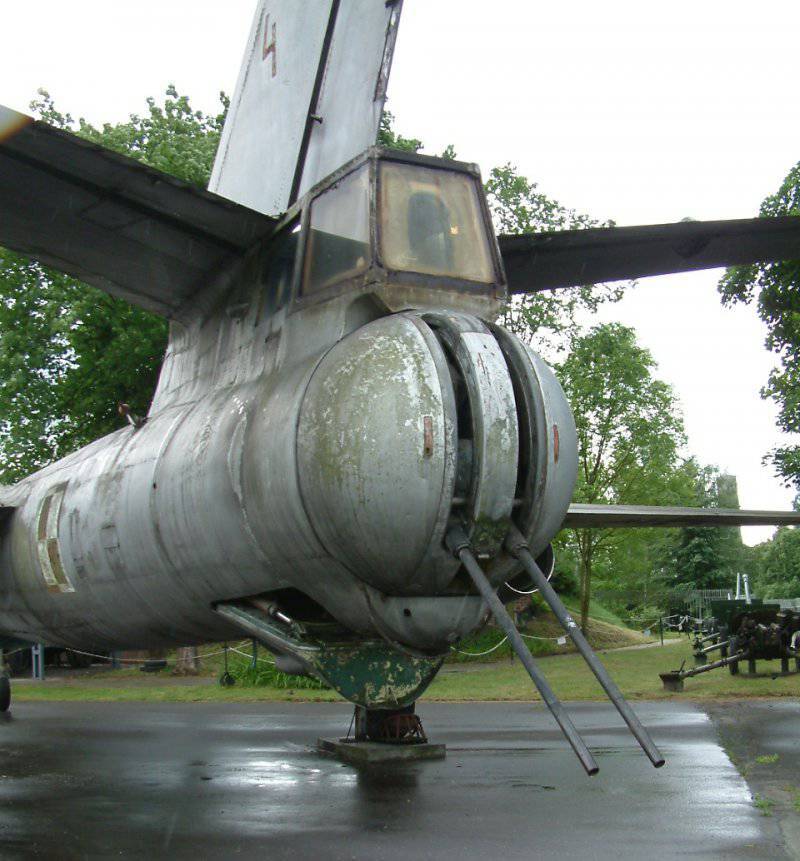
Information